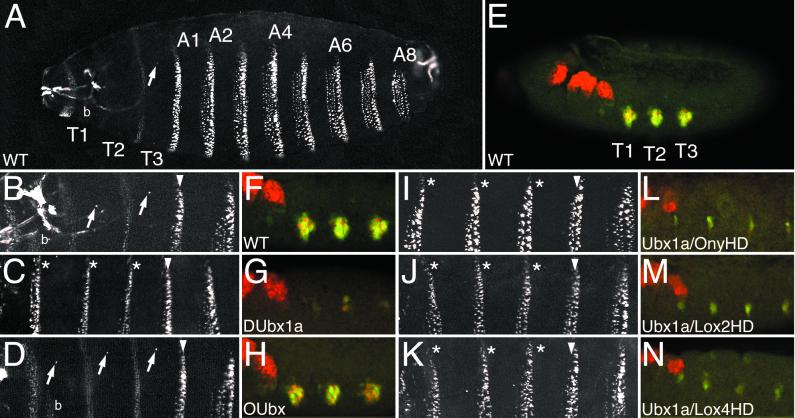Figure 4.
OUbx does not transform embryonic ectoderm segmental identity or repress the Dll target gene. (A and B) Wild-type embryonic cuticle (A) and higher magnification of thorax and anterior abdomen (B). (C) Cuticle transformation of thoracic segments toward A1 fate when ectopic DUbx1a is expressed under the control of armadillo-Gal4. Transformed denticle belts are indicated with asterisks. (D) Ectopic expression of OUbx does not transform the thoracic denticle belts toward A1 fate, nor does it repress the development of Keilin's organs or ventral pits (arrows). (E–H) Expression of Dll protein (red) and the Dll304 early thoracic limb enhancer (green) in wild-type (E and F) and transgenic (G and H) embryos. F–H show higher magnification of thoracic segments. (G) Ectopic DUbx1a represses expression of Dll protein and the Dll304 enhancer in the thorax. Some residual expression is typically seen when DUbx is overexpressed (31). (H) Ectopic expression of OUbx does not affect Dll protein or Dll304 expression. (I–K) Ectopic expression of Ubx1a chimeric genes strongly transforms head and thoracic segments toward A1 identity. In I, J, and K, respectively, Ubx1a/OnyHD, Ubx1a/Lox2HD, and Ubx1a/Lox4HD transformed denticle belts are indicated with asterisks. (L–N) Ectopic expression of Ubx1a chimeric genes represses expression of Dll protein (red) and the Dll304 early limb enhancer (green) in the thorax. (L) Ubx1a/OnyHD. (M) Ubx1a/Lox2HD. (N) Ubx1a/Lox4HD. In A and E, T1, T2, T3 are thoracic segments; A1–A8 are abdominal segments; in A, B, and D, b indicates the T1 denticle beard. In B–D and I–K, the A1 segment is indicated with an arrowhead, transformed thoracic segments are marked with asterisks, and arrows point to ventral pits (when present).

